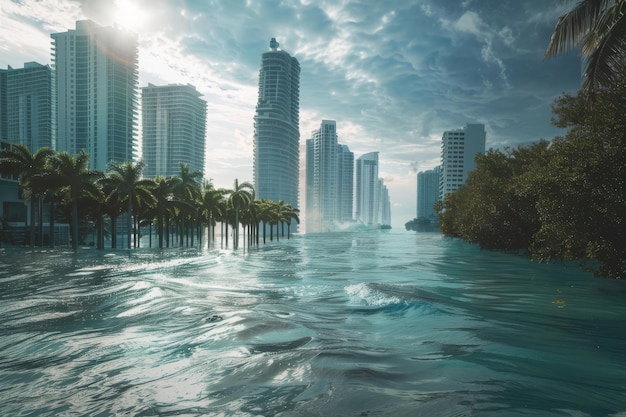The Catastrophic Impact Of Rising Sea Levels On Coastal Areas

Table of Contents
Increased Coastal Erosion and Flooding
Rising sea levels significantly exacerbate existing coastal erosion processes and increase the frequency and severity of coastal flooding, posing a serious threat to coastal communities and infrastructure.
Mechanisms of Coastal Erosion:
The rising ocean levels work in concert with other factors to accelerate coastal erosion. This includes:
- Increased wave action and storm surges: Higher sea levels mean waves have more energy and reach further inland, increasing the erosive power of storms. The increased frequency and intensity of storm surges further amplify this effect, leading to significant beach loss and cliff retreat.
- Saltwater intrusion weakening coastal foundations: Saltwater intrusion weakens the structural integrity of coastal cliffs, foundations, and infrastructure, making them more susceptible to collapse and erosion. This is particularly problematic for structures built near the shoreline.
- Loss of protective sand dunes and vegetation: Sand dunes and coastal vegetation act as natural barriers against erosion. Rising sea levels can submerge these protective features, leaving coastlines more vulnerable to the full force of waves and storms. The loss of these natural defenses increases the rate of erosion considerably.
The Frequency and Severity of Flooding:
Higher sea levels directly translate to more frequent and intense coastal flooding events. Even minor increases in sea level significantly increase the impact of high tides and storm surges. This leads to:
- Damage to property and infrastructure: Coastal flooding causes widespread damage to homes, businesses, and essential infrastructure, leading to substantial economic losses.
- Disruption of transportation networks and essential services: Flooding can disrupt transportation networks, making it difficult to access essential services, including medical care and emergency response.
- Increased risk of waterborne diseases: Contaminated floodwaters can spread waterborne diseases, posing a serious threat to public health.
Saltwater Intrusion and its Consequences
The encroachment of saltwater into freshwater systems is another devastating consequence of rising sea levels, with far-reaching impacts on both human populations and the environment.
Impact on Freshwater Resources:
Rising sea levels lead to saltwater intrusion into freshwater aquifers, which are crucial sources of drinking water and irrigation for agriculture. This has significant consequences, including:
- Degradation of soil quality: Saltwater intrusion contaminates soil, rendering it unsuitable for agriculture and impacting crop yields.
- Loss of agricultural land and productivity: The salinization of farmland leads to decreased agricultural productivity and food shortages.
- Scarcity of clean drinking water: Contamination of freshwater sources necessitates expensive water treatment or forces communities to rely on alternative, potentially unsafe, sources.
Damage to Coastal Ecosystems:
Saltwater intrusion poses a major threat to the delicate balance of coastal ecosystems, impacting biodiversity and ecosystem services. This includes:
- Loss of habitat for various species: Mangrove forests, salt marshes, and other coastal wetlands are vital habitats for a wide range of species. Saltwater intrusion destroys these habitats, leading to biodiversity loss and population decline.
- Disruption of food chains: The loss of key species within coastal ecosystems can trigger cascading effects throughout the food chain, disrupting ecological balance.
- Reduction in carbon sequestration capabilities: Coastal ecosystems, particularly mangroves and seagrasses, play a crucial role in carbon sequestration. Their destruction reduces the planet's ability to absorb carbon dioxide, exacerbating climate change.
Displacement and Migration of Coastal Populations
The relentless erosion and increasing frequency of flooding caused by rising sea levels are forcing coastal communities to abandon their homes and livelihoods, resulting in significant displacement and migration.
Loss of Homes and Livelihoods:
Coastal erosion and flooding lead to the direct loss of homes, businesses, and infrastructure, resulting in:
- Loss of homes and businesses: Communities are forced to relocate, often with significant financial losses and emotional distress.
- Disruption of traditional livelihoods, such as fishing and tourism: The destruction of coastal ecosystems and infrastructure directly impacts livelihoods that depend on healthy coastal environments.
- Increased social and economic inequality: Displacement disproportionately affects vulnerable populations, exacerbating existing social and economic inequalities.
Climate Refugees and Social Instability:
Mass displacement due to rising sea levels creates climate refugee crises and the potential for social instability in both affected and receiving regions. This includes:
- Strain on resources in receiving areas: Influxes of climate refugees can strain resources and infrastructure in areas where displaced populations seek refuge.
- Increased competition for jobs and housing: Competition for limited resources can lead to social tensions and conflict.
- Potential for social unrest and conflict: Large-scale displacement can destabilize communities and create conditions conducive to social unrest and conflict.
Economic Impacts of Rising Sea Levels
The economic consequences of rising sea levels are far-reaching and encompass a wide range of sectors and industries.
Damage to Infrastructure:
Coastal infrastructure faces significant damage from rising sea levels and increased flooding, resulting in enormous economic losses. This includes:
- High costs of repair and reconstruction: Repairing and rebuilding damaged infrastructure is incredibly expensive, placing a significant burden on governments and taxpayers.
- Disruption to trade and commerce: Damage to ports, roads, and other transportation infrastructure disrupts trade and commerce, impacting economic activity.
- Loss of tourism revenue: Damage to coastal areas reduces tourism revenue, impacting local economies and businesses.
Insurance and Economic Losses:
The increasing frequency and severity of coastal disasters lead to higher insurance premiums and significant economic losses. This includes:
- Increased costs for homeowners and businesses: Higher insurance premiums and increased risk of damage make it more expensive to live and operate businesses in coastal areas.
- Financial burden on governments and taxpayers: Governments face increasing costs associated with disaster relief, infrastructure repair, and supporting displaced populations.
- Reduced investment in coastal areas: The increased risk associated with coastal areas can deter investment and economic development.
Conclusion:
The catastrophic impact of rising sea levels on coastal areas is undeniable. From increased erosion and flooding to the displacement of populations and devastating economic losses, the consequences are far-reaching and demand urgent action. Addressing this challenge requires a multifaceted approach, including mitigating greenhouse gas emissions to slow the rate of sea-level rise, implementing effective coastal protection measures, and developing comprehensive adaptation strategies to protect vulnerable communities. We must act decisively to combat the devastating effects of rising sea levels and safeguard the future of our coastal regions. Ignoring this escalating crisis will only exacerbate its catastrophic consequences. Learn more about the solutions to address sea level rise and join the fight for a sustainable future.

Featured Posts
-
 Uruguays Emerging Film Industry Incentives And Opportunities
May 11, 2025
Uruguays Emerging Film Industry Incentives And Opportunities
May 11, 2025 -
 Exec Office365 Breach Millions Made Feds Say
May 11, 2025
Exec Office365 Breach Millions Made Feds Say
May 11, 2025 -
 Remembering A Hero Fremont Firefighter Honored At National Memorial Weekend
May 11, 2025
Remembering A Hero Fremont Firefighter Honored At National Memorial Weekend
May 11, 2025 -
 Astros Foundation College Classic Names All Tournament Team For 2025
May 11, 2025
Astros Foundation College Classic Names All Tournament Team For 2025
May 11, 2025 -
 Se Sorteo El Campeonato Uruguayo De Segunda Division 2025 Fechas Formato Y Equipos
May 11, 2025
Se Sorteo El Campeonato Uruguayo De Segunda Division 2025 Fechas Formato Y Equipos
May 11, 2025
Latest Posts
-
 La Vie D Eric Antoine Apres Le Divorce Nouveau Bebe Nouvelle Compagne
May 12, 2025
La Vie D Eric Antoine Apres Le Divorce Nouveau Bebe Nouvelle Compagne
May 12, 2025 -
 Eric Antoine Bebe Et Nouvelle Compagne Apres Son Divorce
May 12, 2025
Eric Antoine Bebe Et Nouvelle Compagne Apres Son Divorce
May 12, 2025 -
 La Roue De La Fortune Les Resultats D Audience Apres Le Passage D Eric Antoine Sur M6
May 12, 2025
La Roue De La Fortune Les Resultats D Audience Apres Le Passage D Eric Antoine Sur M6
May 12, 2025 -
 Le Divorce D Eric Antoine Et La Naissance De Son Bebe Avec Sa Nouvelle Compagne
May 12, 2025
Le Divorce D Eric Antoine Et La Naissance De Son Bebe Avec Sa Nouvelle Compagne
May 12, 2025 -
 Eric Antoine Et La Roue De La Fortune Sur M6 Les Chiffres D Audience Apres 3 Mois
May 12, 2025
Eric Antoine Et La Roue De La Fortune Sur M6 Les Chiffres D Audience Apres 3 Mois
May 12, 2025
